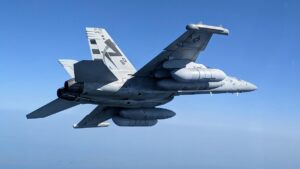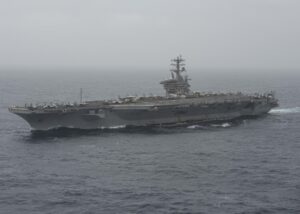According to the recently released Navy Fiscal Year 2023 Budget Highlights book, the service is seeking to end the Snakehead Large Displacement Unmanned Undersea Vehicle (LDUUV) program, decommission the 25 non-carrier-based EA-18G Growler aircraft, and not extend the life of the first Nimitz-class aircraft carrier.
The Navy released its FY ‘23 budget request on March 28, outlining a desire to
retire 24 ships over the next five years. However, the Defense Department did not release all details at the time, including the justification books that detail spending plans and acquisition timelines, saying it needed additional weeks to update the documents with FY ‘22 enacted levels (Defense Daily, March 28).
The Navy said it was seeking to retire nine Freedom-variant Littoral Combat Ships (LCSs), five Ticonderoga-class cruisers, four Whidbey Island/Harpers Ferry-class dock landing ships, two submarines, two oilers, and two Expeditionary Transfer Dock ships (ESD) in an effort to save $3.6 billion over the next five years.
The Budget Highlights book, released April 14, reveals the Navy also plans to eliminate the Snakehead LDUUV program. This cancels the FY ‘22 Phase 2 contract award, which the Navy said will save about $186 million in FY ‘23 and nearly $517 million over the next five years.
The document explained that “misalignment of Snakehead LDUUV design and procurement efforts with submarine hosting interfaces resulted in limited availability of host platforms to conduct Snakehead operations.”
“Cost and schedule delays associated with LDUUV development and Virginia Class SSN integration prohibited further investment. Alternative submarine launch and recovery interface is limited to Modernized Dry Deck Shelter (Mod DDS),” the Navy continued.
The service said three Snakehead vehicles are scheduled to complete modernization between FY ‘22-‘26 and become available for fleet use in FY ‘22, ‘23, and ‘26.
The release of the highlights book comes two months after the Navy christened the first Snakehead prototype vehicle at the Narragansett Bay Test Facility in Newport, R.I. (Defense Daily, Feb. 15).

The Snakehead is an accelerated acquisition program that aims to field a long-endurance multi-mission LDUUV that is able to be deployed from ports, attack submarines, and LCSs. It is the Navy’s largest submarine-launched UUV. The LDUUV was to be used for guidance and control, navigation, situational awareness, and sensors to support intelligence, surveillance and reconnaissance (ISR) and anti-submarine undersea missions.
In 2021, the Navy released a Request for Proposals with plans to competitively award a contract to a single contractor to build two prototypes. The FY ‘22 budget request said the Snakehead program planned for one Phase 1 vehicle to be fabricated in FY ‘21 and undergo in-water testing in FY ‘22. It said Phase 2 would be a competitive award to industry with increased capabilities and potential integration onto surface ships. Phase 2 was expected to be awarded in the first quarter of FY ‘22.
Results from the LDUUV were set to inform the potential transition of Snakehead to an Acquisition Category program as soon as FY ‘25.
The highlights book also said the Navy plans to divest 25 EA-18G Growlers as it decommissions five active component Expeditionary Electronic Attack Squadron to save about $808 million over the next five years, with no savings planned in FY ‘23.
Under this plan, the Navy is divesting of all non-carrier-based Growler support of joint force requirements for tactical airborne electronic attack capability and capacity.
“Divestment involves decommissioning five Growler squadrons, collectively consisting of 25 airframes and approximately 1,020 associated officer and enlisted billets. Military end strength will be reduced by half in FY 2024 and fully in FY 2025,” the Navy said.

Military end strength in these forces will be reduced by half in FY ‘24 and fully by FY ‘25. The Navy said the aircraft will be placed in long term preservation at the Aerospace Maintenance and Regeneration Group (AMARG), half inducted in FY ‘24 and half in FY ‘25.
Another divestment not revealed earlier is the decision by the Navy to reverse an FY ‘22 budget request plan to extend the life of the USS Nimitz (CVN-68) aircraft carrier by another year. The highlights book said this effort would have cost upward of $300 million in maintenance costs “for a small return on investment.”
Navy officials first said they were considering extending the service life of the oldest Nimitz-class carriers almost a year and a half ago.
“We’ve got 40 more years of Nimitz [class] life but Nimitz herself is coming up to potentially an end of life cycle at the end of this [Future Years Defense Program]. But she has capability beyond that point. So we’re looking at where that capability sits, from a timeframe perspective,” Program Executive Officer for Aircraft Carrier Rear Adm. James Downey said in 2020 (Defense Daily, Sept. 17, 2020).
Downey said that generally means the carriers could have 52 to 55 total years of life, if extended. He also noted discussions on extending CVN-68 are “significant” in particular.
However, now the Navy said it decided CVN-68 will retire in FY ‘25 after a 50-year service life. This change specifically aims to save $74 million in FY ‘23 and $339 million over the next five years.
The highlights book argued that on divestments the Department of the Navy (DON) “continues to drive a data-centric, transparent, and outcome-oriented culture for fiscal responsibility during our budget build, focusing on valuation and prioritization of requirements to improve the allocation of resources.”
“Divestment decisions are made to retire less capable platforms, reduce costs, and realign funds to source higher priority efforts. The DON continues to scrutinize the portfolio and divest where appropriate to field the strongest balance of capabilities,” the document added.